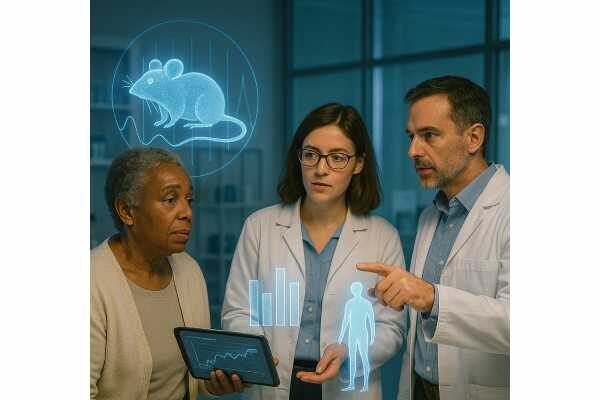Emerging Therapies
Home Emerging Therapies
Emerging Longevity Therapies: What’s Promising and What to Know
Longevity research is moving from concept to clinic, but progress is uneven. Some approaches have human trial data; others remain early-stage or overhyped. This guide sifts through the most discussed therapies, focusing on mechanisms, evidence quality, feasibility, and safety. You will find what looks credible now, what could matter in five to ten years, and how to interpret headlines without losing the nuance. If you are new to the field and want a broader orientation to practical lifestyle levers, see our evidence-based longevity guides. Below we examine categories you are likely to encounter—rapalogs, senolytics, GLP-1 agonists, reprogramming, mitochondrial drugs, and more—and outline when each might be appropriate to discuss with a clinician, what biomarkers to watch, and where the unanswered questions still loom.Table of Contents
Read the complete Longevity Emerging Therapies Guide
What makes a longevity therapy promising?
A promising longevity therapy does three things well: it targets a tractable aging mechanism, improves clinically meaningful outcomes, and does so with acceptable risk over long horizons. Mechanism matters because aging is not a single process. It includes genomic instability, epigenetic drift, mitochondrial dysfunction, impaired proteostasis, cellular senescence, stem cell exhaustion, and altered intercellular communication. A drug that nudges one hallmark may not shift the trajectory of late-life disease unless it also changes hard endpoints—frailty progression, disability, hospitalization, cardiovascular events, neurocognitive decline, or mortality. Evidence should be graded by context:- Preclinical signals. Rodent lifespan extension or reversal of age-related phenotypes is encouraging but not dispositive. Cross-species replication and dose–response data increase confidence.
- Human biomarker change. Improvements in HbA1c, blood pressure, inflammatory cytokines, or epigenetic clocks are helpful leading indicators, but they remain surrogates unless validated against outcomes.
- Clinical outcomes. Randomized trials showing fewer events (falls, infections, cardiovascular endpoints), better function (gait speed, grip strength, VO2peak), or improved quality of life carry the most weight.
- External validity. Effects in healthy midlife adults can differ from those in frail older adults or people with chronic disease. Safety margins tighten with age and polypharmacy.
- Is the target causally tied to age-related disease in humans? Mendelian, pharmacologic, and longitudinal data help.
- Are there plausible, trackable biomarkers that move in the right direction? Choose a compact panel aligned to mechanism.
- Do we have reason to believe benefits will outweigh risks at realistic doses and durations? Look for dose-finding and long-term follow-up, not just short trials.
Rapamycin and metformin: what trials show
Two of the most discussed longevity drugs are rapamycin (and its analogs) and metformin. They aim at different levers—nutrient-sensing versus insulin sensitivity—but share a theme: modest pathway rebalancing may delay multiple diseases. Rapamycin and rapalogs. Rapamycin inhibits mTORC1, a central node in growth and autophagy regulation. In animals, intermittent dosing extends lifespan and improves vaccine responses in old mice. In humans, rapalogs have improved flu vaccine immunogenicity in older adults at low doses and have shown signals on immune function and skin aging in small trials. The trade-off is dose: higher, chronic exposure can impair wound healing, raise triglycerides, cause mouth ulcers, and increase infection risk. If this category appeals, get familiar with biomarkers to watch—lipids (especially triglycerides), fasting glucose, CBC, CRP, and renal function—and how to adjust cadence. For a deeper dive on dosing models and risk management, see rapamycin evidence and dosing. Metformin. This insulin-sensitizer dampens hepatic gluconeogenesis and improves peripheral glucose uptake. Epidemiology suggests lower incidence of some age-related diseases among people with type 2 diabetes on metformin compared with other agents, though confounding is substantial. Trials in non-diabetic adults show small improvements in insulin sensitivity and inflammatory markers, with gastrointestinal side effects as the main limitation. Debate continues about metformin’s interaction with exercise adaptations—some studies show blunted mitochondrial responses, others do not. Until large outcomes trials in non-diabetics read out, metformin remains a reasonable option for people with prediabetes or metabolic syndrome when diet and activity are insufficient. For a balanced review of clinical data, see metformin for healthy aging. Practical takeaways.- Consider rapalogs in research settings or with specialist oversight, favoring intermittent dosing and vigilant lab monitoring.
- Consider metformin when metabolic risk is present and lifestyle levers are maximized; avoid “just in case” use in highly trained athletes until the exercise question is clearer.
- In both cases, individualize: age, comorbidities, and goals matter.
GLP-1 and cardiometabolic aging
Glucagon-like peptide-1 receptor agonists (GLP-1 RAs) and related dual agonists have changed obesity and diabetes care. Their relevance to longevity is twofold: they induce sustained weight loss and improve cardiovascular risk factors, and emerging trials show reductions in events in high-risk populations. Adipose tissue is not metabolically inert; excess visceral fat fuels inflammation, ectopic lipid deposition, and insulin resistance—drivers of vascular aging. What they do. GLP-1 RAs slow gastric emptying, enhance insulin secretion in a glucose-dependent manner, and reduce appetite through central pathways. Average weight loss in obesity trials often ranges from 10–20 percent, with greater reductions at higher doses. Blood pressure, triglycerides, and liver fat typically fall. Sleep apnea severity and joint load may improve as secondary benefits of weight loss. Longevity implications. Weight reduction in midlife could delay the onset of type 2 diabetes, fatty liver disease, and osteoarthritis, indirectly extending healthspan. Cardiovascular outcome trials in diabetes already show fewer major adverse events for some agents, suggesting benefits beyond glycemia. Whether similar advantages extend to lower-risk, non-diabetic individuals is an active area of research. Caveats and open questions. Nausea and GI symptoms are common early on; gallbladder events and micronutrient issues can occur with rapid weight loss. Regain is likely after discontinuation without a durable lifestyle scaffold. The effect on lean mass warrants attention: even with significant fat loss, a portion of the weight reduction is lean tissue. Resistance training and sufficient protein (around 1.2–1.6 g/kg/day for most adults without kidney disease) help preserve muscle. For a focused appraisal of their role in healthy aging, see GLP-1s and longevity. Who might consider therapy? Adults with obesity or overweight plus weight-related comorbidities who have not succeeded with structured lifestyle interventions. Discuss risks, cost, and the need for a long-term plan that pairs medication with training, diet quality, sleep, and stress management. GLP-1 RAs are not classic “anti-aging” drugs; they are metabolic disease therapies with ripple effects across aging biology. That is precisely why they matter. Back to top ↑Senolytics and senomorphics: where we are now
Senescent cells stop dividing but do not remain silent; they secrete inflammatory and matrix-remodeling factors known as the senescence-associated secretory phenotype (SASP). With age, senescent cells accumulate in multiple tissues and appear to impair regeneration, drive fibrosis, and amplify chronic inflammation. Two therapeutic strategies have emerged:- Senolytics aim to eliminate senescent cells by exploiting their survival dependencies (for example, BCL-2 family inhibition).
- Senomorphics aim to suppress the SASP or modulate senescence without killing the cells.
- Avoid self-experimentation with chemotherapeutics or potent apoptosis inducers outside trials.
- Think in cycles: if senolytics pan out, they will likely be used intermittently with recovery periods and careful lab monitoring (CBC, liver enzymes).
- Match mechanism to phenotype: fibrosis-heavy diseases may respond differently than metabolic conditions.
Partial reprogramming and epigenetic drugs: promise versus risk
Cellular reprogramming resets epigenetic marks and can, in principle, restore youthful gene expression patterns. Full reprogramming (the original Yamanaka factors) converts cells to pluripotency—powerful but tumor-prone. Partial reprogramming pulses subsets of factors (often OSK) to rejuvenate without losing identity. In mice, cyclic OSK expression in certain tissues improves function and can reverse some epigenetic aging signatures. Translation to humans requires vectors, tissue specificity, tight control, and a robust safety margin against dedifferentiation, arrhythmia, and oncogenesis. For a grounded discussion of timing, vectors, and safety controls, see partial cellular reprogramming. Small-molecule epigenetic rejuvenators attempt to coax similar effects without gene therapy. Candidates target chromatin modifiers (e.g., HDACs, sirtuins) or DNA repair pathways and aim to restore youthful chromatin accessibility while preserving cell identity. These compounds could be orally dosed and tunable, but specificity is challenging: the epigenome is not a single dial. Off-target transcriptional changes can disrupt immune function, fertility, or neurodevelopmental pathways. Explore the landscape and screening criteria in epigenetic rejuvenation compounds. What would success look like?- Tissue-specific delivery (eye, muscle, or heart) that improves structure and function without increasing neoplasia.
- Biomarker convergence: epigenetic clocks, proteomic age, and functional endpoints (e.g., gait speed, ejection fraction) moving together.
- Reversibility and a clear off-switch.
Mitochondrial and cellular energy therapies
Mitochondria integrate signals from nutrient sensing, inflammation, and mechanical stress to decide between energy production, repair, and apoptosis. Aging mitochondria accumulate mutations in mitochondrial DNA (mtDNA), lose membrane potential, and generate more reactive oxygen species under stress. Therapies therefore split into two broad strategies: protect and repair existing mitochondria, and edit or replace damaged genetic templates. Protect and repair. Compounds such as elamipretide bind cardiolipin to stabilize inner mitochondrial membranes, improving electron transport efficiency in models of heart and skeletal muscle dysfunction. Early human studies report improvements in exercise tolerance and cardiac parameters in select populations, though results vary by indication. Autophagy-targeted strategies—enhancing mitophagy to cull damaged mitochondria—offer another path to restore network quality. Nutrient-sensing modulators that tilt mTORC1 and AMPK toward repair, or ULK1 activation, may boost recycling of defective organelles. For mechanism-driven summaries, see mitochondrial therapies and complementary work on autophagy-targeted drugs. Edit or replace. Precision tools that target mtDNA mutations—using base editors or novel delivery systems—are advancing, but clinical use remains nascent. Challenges include delivering editors to the correct mitochondrial compartment, avoiding immunogenicity, and ensuring that corrected genomes outcompete damaged ones within the same cell. How to evaluate candidates.- Biomarkers: VO2peak, six-minute walk distance, phosphocreatine recovery time by 31P-MRS, lactate response to submaximal exercise, and tissue-specific imaging.
- Populations: Benefits may be largest in mitochondrial disease, heart failure, sarcopenia, or frailty—conditions where energetic inefficiency is central.
- Safety: Watch for arrhythmias, liver enzymes, and off-target effects on cell death pathways.
Telomerase and chromosomal maintenance
Telomeres cap chromosome ends and shorten with each cell division, acting as a rough ledger of replicative history and oxidative stress. Critically short telomeres trigger DNA damage responses, senescence, and apoptosis that can degrade tissue function. Telomerase—an enzyme complex with TERT (the catalytic subunit) and TERC (the RNA template)—extends telomeres in germ cells, stem cells, and many cancers, but is low in most somatic tissues. Longevity therapies here aim to restore telomere reserve or protect chromosome integrity without tipping into oncogenic risk. What is plausible now. In animal models, telomerase activation can improve tissue regeneration and extend lifespan when delivered late in life, especially in strains with accelerated telomere attrition. The mechanisms likely extend beyond length alone: telomerase interacts with mitochondrial signaling and DNA repair pathways, potentially reducing reactive oxygen species and improving cell survival under stress. In humans, short leukocyte telomeres correlate with higher risk for cardiovascular disease and all-cause mortality, but correlation does not guarantee that lengthening will improve outcomes. The central uncertainty is whether periodic, tissue-targeted telomerase upregulation can safely restore function in older adults without increasing cancer incidence. Therapeutic strategies.- Gene therapy. Adeno-associated virus (AAV) vectors that deliver TERT to specific tissues are under preclinical and very early translational exploration. Dosing, tissue specificity, and immune responses to the vector are the crucial hurdles, alongside surveillance for clonal expansions.
- Small-molecule and RNA approaches. Compounds that stabilize telomeric structures or modulate shelterin components might slow attrition; others seek to increase endogenous telomerase transiently. To date, human data are limited to biomarker movement, not outcomes.
- Lifestyle levers. Telomere dynamics respond to cumulative inflammatory and metabolic stress. While not “therapies,” improving cardiorespiratory fitness, sleep regularity, and diet quality reduces the rate of attrition and lowers oxidative burden—factors that any pharmacologic attempt must work alongside.
Plasma, extracellular vesicles, and parabiosis-inspired approaches
Classic heterochronic parabiosis experiments—joining the circulatory systems of old and young mice—suggest that the blood milieu can modulate tissue repair and inflammation. Translation has followed two tracks: removing putative inhibitors (therapeutic plasma exchange) and adding youthful signals (young plasma fractions, exosomes, and engineered extracellular vesicles). Therapeutic plasma exchange (TPE). TPE removes plasma proteins and replaces them with albumin and saline, acutely lowering circulating autoantibodies, inflammatory cytokines, and other factors. In aging contexts, pilot studies report improved biomarkers and anecdotal functional gains, but rigorous, long-term outcomes data are limited. The most compelling nearby use cases involve autoimmune flares and certain neurologic conditions, which provide a mechanistic rationale for trials of periodic exchange in age-associated inflammatory states. For an organized primer on protocols and candidate indications, see plasma-based therapies. Young plasma fractions and proteins. Candidate “pro-youth” factors (e.g., certain growth differentiation or chemokine signals) have shown tissue-specific benefits in animals, but dose, timing, and tissue targeting remain open questions. Whole young plasma is unlikely to be the long-term solution; fractionation and recombinant production are more scalable, safer routes if specific drivers are validated. Exosomes and extracellular vesicles (EVs). EVs are lipid-bound packets carrying microRNAs, proteins, and lipids that deliver messages between cells. Mesenchymal stromal cell (MSC)-derived exosomes reduce inflammation and enhance repair in preclinical models of ischemia, fibrosis, and neurodegeneration. Advantages include lower immunogenicity than whole-cell therapies and engineerability (cargo loading, surface targeting). Challenges include manufacturing standards (potency assays, cargo consistency), biodistribution, and ensuring that beneficial signals outweigh pro-fibrotic or oncogenic cargo. Explore progress and pitfalls in exosomes and extracellular vesicles. Trial design pointers.- Use organ-specific outcomes (e.g., six-minute walk distance and NT-proBNP in heart failure; MRI diffusion metrics in white-matter disease) rather than sole reliance on “biological age” clocks.
- Include safety endpoints tailored to the approach: coagulopathy and hypocalcemia for TPE; alloimmunization and transfusion reactions for plasma fractions; thrombosis and ectopic signaling for exosomes.
- Plan for repeat dosing studies to probe durability and potential tachyphylaxis.
Immune rejuvenation and thymus regeneration
Immune aging manifests as immunosenescence (poor responses to new antigens) and inflammaging (chronic, low-grade inflammation). The thymus—where T cells mature—atrophies from puberty onward, shrinking naïve T-cell output and limiting repertoire diversity. Strategies to rejuvenate immunity span thymic regeneration, cytokine and hormone cues, and senescence-targeted immunotherapies. Thymic regeneration. Small trials have tested combinations of growth hormone, metformin, and DHEA to stimulate thymic regrowth and improve immune markers over one to two years. Imaging and T-cell receptor (TCR) repertoire data suggest partial restoration in some participants, though randomized evidence is limited. Safety requires endocrine oversight: growth hormone can alter glucose tolerance, fluid balance, and IGF-1 signaling. A pragmatic development path would prioritize short pulses with careful glycemic monitoring, paired with functional endpoints like vaccine response and infection rates. For a structured review of human attempts and next steps, see thymus regeneration and immune rejuvenation. Klotho, FGF21, and other endocrine cues. Aging immune function cross-talks with endocrine networks. Klotho and FGF21 influence metabolic homeostasis, phosphate handling, and cellular stress responses with downstream effects on immunity. Recombinant proteins or small molecules that enhance these axes may indirectly bolster immune resilience by reducing metabolic inflammation. For a broader endocrine perspective, our review of hormone-based rejuvenation outlines candidates and safety considerations. Senescence-targeted immunotherapy. Instead of killing senescent cells with small molecules, vaccines or CAR-T therapies can train the immune system to recognize senescent-cell antigens and clear them. Preclinical studies indicate improved tissue function with fewer off-target toxicities than systemic chemotherapy. Translation will hinge on finding conserved, safe targets on senescent cells and preventing immune escape. For mechanisms and early platforms, see senescence-targeted immunotherapy. What to measure. Beyond CBC and CRP, immune age can be tracked with TCR diversity, naïve-to-memory T-cell ratios, vaccine antibody titers, and inflammaging panels (IL-6, TNF-α, soluble TNF receptors). Functional readouts—the number of respiratory infections, days of antibiotics per year, or responses to new vaccines—anchor biomarker shifts to real outcomes. Immune rejuvenation is about quality and coordination rather than indiscriminate stimulation. Expect progress through layered approaches: microinflammation control, thymic support, better vaccines, and targeted removal of dysfunctional immune actors. Back to top ↑Microbiome and metabolic crosstalk
The gut microbiome shifts with age: reduced diversity, more pro-inflammatory taxa, and lower production of beneficial metabolites such as short-chain fatty acids (SCFAs). These changes influence metabolic control, immune tone, and barrier integrity, with downstream effects on cardiovascular and neurocognitive health. Longevity-directed microbiome strategies aim to rebalance communities and augment beneficial metabolites without unintended blooms or pathogen transfer. Therapeutic levers.- Defined consortia. Rather than single probiotics, next-generation consortia deliver engineered or curated strains that produce SCFAs, bile acid modifiers, or neurotransmitter precursors. The goal is predictable metabolism and colonization resistance against opportunists.
- Fecal microbiota transplantation (FMT). FMT can reset microbial communities, but safety concerns (transmission of multidrug-resistant organisms) and variable durability argue for stricter donor screening and, ideally, standardized, capsule-based products. FMT may be best confined to well-defined indications while we build evidence for aging-related endpoints.
- Postbiotics. Direct delivery of metabolites (e.g., butyrate prodrugs), cell wall components, or engineered vesicles seeks to capture benefits without live organisms. This may suit older adults with immunosuppression where infection risk matters.
Vascular stiffness and crosslink breaking
As arteries age, collagen crosslinks accumulate and elastin fragments. Advanced glycation end-products (AGEs), particularly glucosepane, form sturdy bridges that stiffen the arterial wall, elevate systolic pressure and pulse wave velocity, and strain the heart and microvasculature. Lifestyle and antihypertensives help, but directly targeting crosslinks is an appealing, mechanism-based strategy. What has been tried. Early “crosslink breakers” like alagebrium (ALT-711) showed mixed results on vascular stiffness parameters and did not achieve broad clinical adoption. The limitations—insufficient potency against dominant human crosslinks like glucosepane, uncertain tissue penetration, and inconsistent outcomes—shaped the next generation of discovery: enzymatic or catalytic approaches designed specifically for glucosepane and related structures. What could work next.- Glucosepane-directed chemistry. High-specificity molecules that recognize glucosepane’s unique bridge could, in theory, cleave crosslinks without harming normal collagen. Delivery must reach the medial layer of large arteries and cartilage where crosslinks accumulate.
- Adjacencies: Compounds that reduce new crosslink formation by lowering glycemic variability, oxidative stress, or dicarbonyl intermediates (like methylglyoxal) may slow progression, complementing any breaker therapy.
- Imaging and endpoints. Surrogates such as carotid–femoral pulse wave velocity, augmentation index, and MRI-based aortic distensibility can move within months; paired with ambulatory blood pressure and left ventricular mass by echocardiography, they capture clinical relevance beyond a lab value.
Smart combinations and trial design
No single lever controls aging. The most effective strategies will likely stack complementary mechanisms while preserving safety. Doing that responsibly requires smarter trials that balance ambition with clarity. Principles for stacking.- Orthogonal mechanisms. Pair interventions that address distinct hallmarks with minimal overlapping toxicities—for example, a metabolic therapy with a periodic repair pulse (autophagy or senescent-cell clearance).
- Temporal sequencing. Start with metabolic normalization (weight, blood pressure, glycemia) to lower baseline risk; layer repair/renewal pulses (e.g., intermittent rapalog or senolytic cycles) when labs are stable; consider signal augmentation (EVs or endocrine cues) after inflammation cools.
- Dose minimalism. Use the lowest effective dose and longest effective interval. Aging biology rewards tunable interventions more than constant, high-intensity pressure.
- Shared biomarkers. Choose a concise panel that reflects each mechanism: e.g., HbA1c or CGM metrics for metabolic therapies; lipids, CRP, lymphocyte subsets for rapalogs; p16INK4a expression or senescence-associated β-gal surrogates in tissue where feasible; VO2peak or gait speed as cross-cutting function.
- GLP-1 or dual agonists + resistance training + protein optimization (1.2–1.6 g/kg/day): Preserve lean mass during fat loss, lower inflammatory tone, and improve hemodynamics.
- Periodic senolytic cycles + autophagy support: Reduce dysfunctional cell burden, then promote cleanup and renewal.
- Mitochondrial protectant + endurance intervals: Combine improved electron transport efficiency with stimulus for mitochondrial biogenesis.
- Acarbose or other postprandial modulators + microbiome consortia: Smooth glucose excursions while promoting SCFA production; see our synthesis on acarbose and longevity for mechanism and human signals.
References
- The potential of rapalogs to enhance resilience against infections and to attenuate inflammation in older adults 2021 (Systematic Review)
- Semaglutide and Cardiovascular Outcomes in Obesity without Diabetes 2023 (RCT)
- Senolytics in idiopathic pulmonary fibrosis: Results from a first-in-human, open-label, pilot study 2019 (Pilot Study)
- Gene Therapy-Mediated Partial Reprogramming Extends Lifespan and Reverses Aging in Mice 2024 (Preclinical)
- Elamipretide: A Review of Its Structure, Mechanism of Action and Clinical Development 2025 (Review)
























